The Lady with an Ermine at the Czartoryski Museum
The Lady with an Ermine: the Mystique of a Renaissance Masterpiece at the Czartoryski Museum in Krakow
The Lady with an Ermine, one of Leonardo da Vinci’s masterpieces, is prominently displayed in the Czartoryski Museum in Krakow, Poland. Created between 1489 and 1490, this captivating portrait features Cecilia Gallerani, a young woman at the Milanese court who was also the mistress of Ludovico Sforza, the Duke of Milan. As you explore the history and mystery behind this exquisite painting, you’ll not only appreciate the undeniable genius of da Vinci but also gain insight into the art world during the Italian Renaissance.
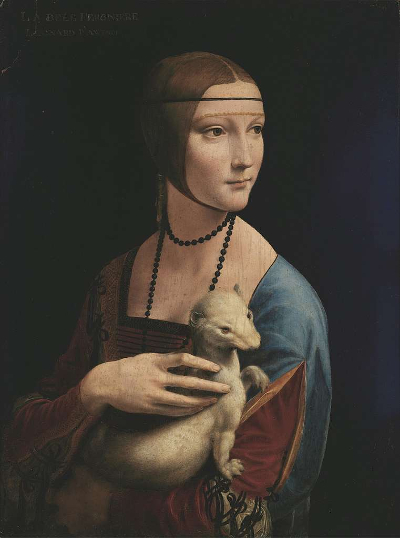
Visiting the Czartoryski Museum, you’ll have the opportunity to immerse yourself in one of Poland’s most remarkable European art collections.
The world-famous Lady with an Ermine rests alongside other priceless masterpieces, creating an unforgettable experience for any lover of art and history.
While strolling through the galleries, you’ll undoubtedly marvel at the beauty and depth of da Vinci’s work and appreciate how the Czartoryski Museum has become a seminal cultural institution in Krakow.
Table of Contents:
Background of the Painting
The Lady with an Ermine is a remarkable painting created by Leonardo da Vinci between 1489 and 1491. This exquisite piece of art belongs to the Renaissance era, a time of great innovation and cultural development.
The portrait showcases a young woman holding a small, delicate ermine in her arms, gently conveying the tender bond between them.
As you explore the background of this painting, it’s essential to know that Leonardo da Vinci was a court painter for Ludovico Sforza, the Duke of Milan, when he created this masterpiece.

Sforza commissioned the piece, which is one of only four surviving portraits of women painted by Leonardo. The Lady with an Ermine is believed to depict Cecilia Gallerani, Sforza’s mistress, and its intricate details illustrate the artist’s talent for capturing his subject’s emotions and personality.
The Czartoryski Museum, where the painting is currently housed, has a rich history that adds further depth to the story of the Lady with an Ermine.
The portrait was purchased in Italy in 1798 by Adam Jerzy Czartoryski, and it has been part of the museum’s collection ever since. However, the painting’s tumultuous journey did not end there. During World War II, the portrait was stolen by the Nazis and sent to the Kaiser Friedrich Museum in Berlin, before eventually being recovered and returned to its rightful home in Kraków, Poland.
During your visit to the Czartoryski Museum, it is worth taking the time to appreciate the other masterpieces displayed alongside the Lady with an Ermine.
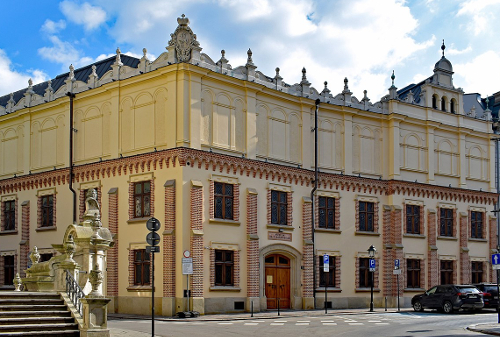
The museum is home to an impressive array of Etruscan, Egyptian, Roman and Greek antiquities, giving you the opportunity to explore the breadth and depth of human creative achievements throughout history.
Symbolism and Interpretation
Ermine
The ermine in the painting is a symbolic representation, holding deep meaning and context. In the artwork, the ermine symbolises purity and moderation.
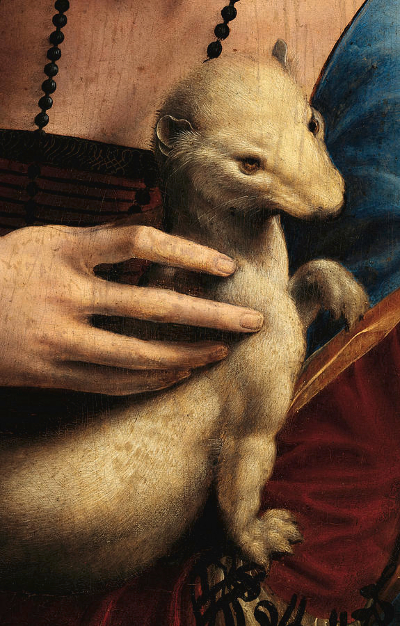
Traditionally, the ermine was thought to be an animal that would choose death over soiling its pristine white fur, which made it an emblem of virtue.
Additionally, its presence in the portrait also represents the subject’s affiliation with the House of Sforza, as the ermine was an emblem in their coat of arms.
Cecilia Gallerani
Cecilia Gallerani, the subject of the painting, was Ludovico Sforza’s mistress. As you view the painting, you can appreciate the subtle connection between her and the ermine.
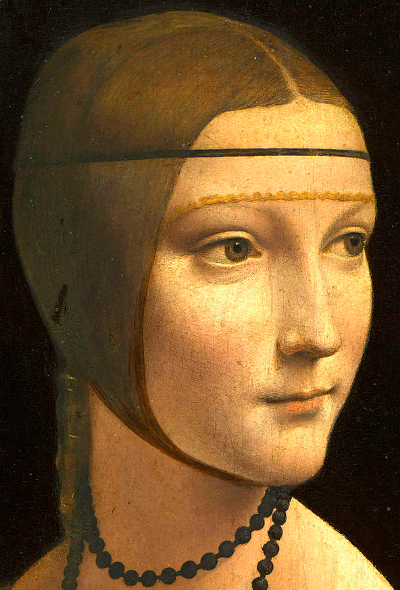
Leonardo da Vinci masterfully captures her gaze towards something out of frame, speculated to be Ludovico himself. This connection suggests that the artist intentionally portrayed her with this powerful symbol, both as a nod to the House of Sforza and as an embodiment of the virtues represented by the ermine.
In conclusion, understanding the symbolism and interpretation of ‘The Lady with the Ermine’ is vital for appreciating the depth and mastery of Leonardo da Vinci’s work.
By acknowledging the presence of the ermine as a symbol of purity, moderation, and familial connection, you can see how da Vinci ingeniously interwove his subject’s life and affiliations into his phenomenal artwork.
History and Provenance
The Lady with an Ermine, a famous painting by Leonardo da Vinci, is currently on display at the Czartoryski Museum in Kraków. The museum was established by Princess Izabela Czartoryska, the family matriarch and art lover, who founded the first art museum in Poland in the family’s residence in Pulawy in 1796.
In 1798, the painting was purchased in Italy by Adam Jerzy Czartoryski, the son of Princess Izabela.
Along with Leonardo’s masterpiece, Adam also acquired Raphael’s “Portrait of a Young Man”; however, the latter was sadly lost during the Nazi invasion of World War II.
Initially, the Czartoryski Museum was located in the Hôtel Lambert, but after the November Uprising in 1830, the collection was transferred to Kraków, where it now resides. During the tumultuous years of World War II, the Lady with an Ermine went through a perilous journey, moving across borders, hidden from the Nazis, and ultimately returning to Kraków.
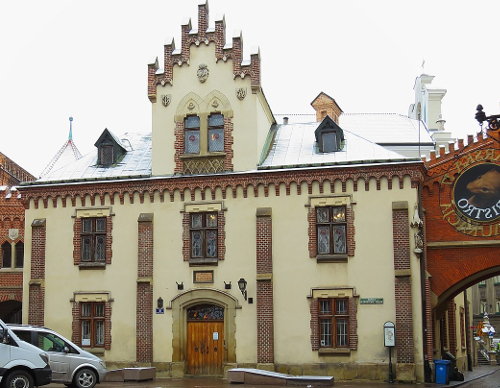
In addition to the Lady with an Ermine, the Czartoryski Museum houses a remarkable collection of Etruscan, Egyptian, Roman and Greek antiquities, celebrating the vibrant history and cultural heritage of the times.
Your visit to the museum will be an enlightening experience, as you immerse yourself in the rich and fascinating legacy of the Czartoryski family and their impact on Polish cultural institutions.
Journey of the Painting
From Milan to Kraków
The fascinating story of Leonardo da Vinci’s Lady with an Ermine began in the late 15th century.
Painted around 1489-1490, this portrait of Cecilia Gallerani was commissioned by Ludovico Sforza, the Duke of Milan and Gallerani’s lover.
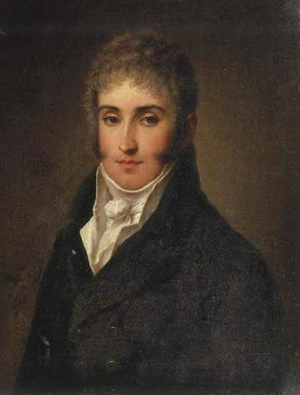
Over the centuries, the painting found its way to Poland, where in 1798, Adam Jerzy Czartoryski purchased it, along with Raphael’s “Portrait of a Young Man” for his family’s art collection. The Lady with an Ermine has since become a key exhibit at the Czartoryski Museum in Kraków.
During World War II
World War II took a toll on the painting’s serene existence in Kraków. The Nazis stole the Lady with an Ermine and sent it to the Kaiser Friedrich Museum in Berlin.
Despite the devastating loss of Raphael’s “Portrait of a Young Man” during the invasion, the Lady with an Ermine ultimately managed to escape further harm in the war years.
Return to Kraków
After the war, the painting was recovered and returned to its rightful home in the Czartoryski Museum. Its return marked a significant cultural victory for Poland, as the Lady with an Ermine has become one of the nation’s cherished treasures.
The painting has since been on display for the public to admire, solidifying its place in the vibrant history and artistic legacy of Kraków.
Art Collection and Conservation
At the Czartoryski Museum, you will find an impressive art collection with works from some of the most renowned artists in history.
The collection was started by Prince Adam Jerzy Czartoryski in the late 18th century when he acquired the famous painting ‘The Lady with an Ermine’ by Leonardo da Vinci, as well as Raphael’s ‘Portrait of a Young Man’, which was unfortunately lost during World War II.
The Czartoryski Museum serves as a national repository of valuable works of art and is dedicated to their conservation and exhibition. The variety of artworks spans different time periods and regions, making it an essential cultural institution.
Some of the noteworthy artists featured in the museum’s rich collection include:
- Raphael – an Italian painter celebrated for his contribution to the High Renaissance
- Rembrandt – a Dutch Baroque painter; his work ‘Landscape with the Good Samaritan’ is part of the collection
- Hans Holbein the Younger – a renowned German portraitist
- Luca Giordano – an Italian Baroque painter and print-maker
Not only does the Czartoryski Museum boast an extraordinary collection of portrait paintings, but it also features an impressive assortment of Egyptian, Etruscan, Roman, and Greek antiquities.
Additionally, the museum contains important pieces such as ‘La Belle Ferronnière’, another masterpiece by Leonardo da Vinci. This highlights the museum’s dedication to collecting and preserving works of art from diverse historical periods and artists.
When visiting the Czartoryski Museum, you will appreciate the efforts taken to protect these invaluable pieces of art through conservation and proper display techniques. By doing so, the museum ensures that future generations can continue enjoying and learning from the art collection it houses.
Comparison with Other Da Vinci Masterpieces
When you view the Lady with an Ermine, you may instantly notice its distinct style and portrayal of its subject, Cecilia Gallerani, the mistress of Leonardo da Vinci’s Milanese employer, Ludovico Sforza. As you dive deeper into the world of da Vinci’s art, you can compare this masterpiece with other famous works such as the Mona Lisa and The Last Supper.
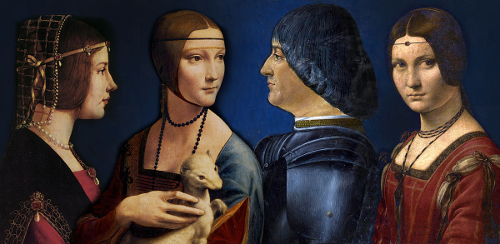
The Mona Lisa, housed in Paris, is known for its enigmatic smile and intricate background. Although both portraits are of women, you can observe significant differences in their presentation.
The Lady with an Ermine showcases the subject interacting with an animal, while the Mona Lisa solely depicts the woman. The use of light and shadow in both paintings reflects da Vinci’s mastery of the oil painting technique, but the Lady with an Ermine stands out for its unique chiaroscuro effect that emphasises the subject’s realistic features.
Exploring The Last Supper, you find another aspect of da Vinci’s artistic abilities compared to the Lady with an Ermine. The Last Supper is a massive mural in Milan, displaying a biblical scene filled with deep symbolism and emotion. It demonstrates da Vinci’s ability to capture the essence of an event, unlike the intimate and personal nature of the Lady with an Ermine.
As you reflect on the Lady with an Ermine in relation to other da Vinci masterpieces, you can appreciate:
- The distinctive portrayal of women in both the Lady with an Ermine and the Mona Lisa
- The exceptional use of oil painting techniques to highlight realism in the subjects
- The stark contrast in themes between intimate portraits and grand biblical scenes, such as The Last Supper
By assessing these key factors, you can gain a deeper understanding of da Vinci’s diverse range of masterpieces and the impact of his innovative techniques on the art world.
Recommended articles:
- 17 Interesting and Fun Facts About Poland
- Best Pet-friendly Places in Krakow
- Exploring the Lesser-Known Neighbourhoods of Krakow
- From Krakow: Slovakia Treetop Walk, Zakopane & Thermal Spa
- Guide to Krakow’s Must-See Shows and Musicals
- Chopin Piano Recital at Chopin Concert Hall
- Krakow’s Best Summer Festivals and Events
- Krakow: Medieval History City Walking Tour
- Theme Parks near Krakow
- TOP 20 Most Scary Polish Folklore Creatures
Impact on Later Artists
High Renaissance
Leonardo da Vinci’s “Lady with an Ermine” remarkably influenced the High Renaissance artists, such as Giovanni Bellini.
By featuring realistic depictions with minute attention to detail, the painting inspired other painters to adopt this innovative approach.
Florentine artists like Bellini, for instance, had adopted da Vinci’s sfumato technique, which blurred the edges of objects, creating a more cohesive and harmonious composition. By observing this masterpiece, you can see how it not only shaped Italian painters but also played a vital role in the development of the High Renaissance as a whole.
European Art
The impact of “Lady with an Ermine” extends beyond the Italian borders, reaching European art broadly. As a visual exemplar of the Renaissance ideals, this artwork encouraged artists to pursue the humanistic spirit, adopting realism and new techniques.
A more precise representation of the human form became a focus in European art during this time. As you study da Vinci’s “Lady with an Ermine,” you may notice the meticulous intricacy that eventually became a desirable trait in European art, rivalling artists’ techniques from various artistic schools.
In summary, “Lady with an Ermine” at the Czartoryski Museum has had a lasting influence on artists from the High Renaissance period to European art in general. You can identify its contributions to the refinement of artistic techniques and the emphasis on realism, which later generations of artists emulated and built upon.
Czartoryski Museum and Its Collection
The Czartoryski Museum is a notable art collection housed within the National Museum in Kraków, Poland. Founded in 1796 by Princess Izabela Czartoryska, it is considered one of the oldest museums in the country.

As you explore this fascinating institution, you will come across priceless artworks and artefacts of great historical significance.
At the heart of the Czartoryski Museum lies Leonardo da Vinci’s “Lady with an Ermine”, one of only four portraits of women by the master. This exquisite piece, dated around 1490, features Cecilia Gallerani, the young mistress of Ludovico Sforza, the Duke of Milan.
This painting holds a special place in the collection, not only due to its artistic value but also its chequered history, which is a testament to the resilience of Polish cultural institutions.
This magnificent museum is part of the larger National Museum in Kraków, which is spread across several locations, including the Wawel Cathedral and the Wawel Royal Castle.
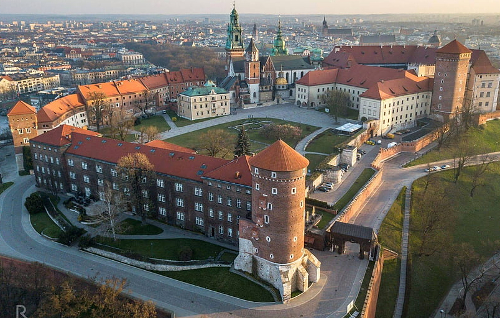
Both of these sites are historically important as they have been central to Polish culture for centuries. The cathedral, in particular, has been the coronation site for Polish monarchs, while Wawel Royal Castle offers a fascinating insight into the past grandeur of Polish royalty.
In addition to the National Museum in Kraków, the Princes Czartoryski Museum and the Czartoryski Palace are two key locations associated with the Czartoryski family.
The palace, once the family’s residence, now houses an eclectic mix of artworks and historical objects. These venues provide you with a unique glimpse into the lives of Polish nobility and the preservation of their cultural heritage.

As you explore the Czartoryski Museum and its surroundings, you will gain a deeper understanding of the rich artistic and historical legacy that Poland holds. Engage with the collections, immerse yourself in their stories, and let the art transport you through the annals of time.
Krakow: Czartoryski Museum Tour
The Czartoryski Museum in Krakow, Poland offers a unique opportunity for art lovers to witness the renowned painting by Leonardo da Vinci, the Lady with an Ermine.
This painting is a brilliant testament to da Vinci’s exceptional skill and is just one of the few portraits painted by him.
The museum also boasts an impressive collection of Etruscan, Egyptian, Roman and Greek antiquities, making it a must-visit destination for anyone exploring the city’s rich history.
Czartoryski Museum Ticket and Guided Tour
To get the most out of your visit, opt for a 1 hr 30 mins guided tour in English, where an experienced guide can provide insights into the history and artistic importance of the displayed artworks, including the ‘Lady with an Ermine’.
Furthermore, one ticket grants you access to all exhibitions at the museum, covering the Palace, Monastery, and the Gallery of Ancient Art.
Keep in mind that entry to the museum is free on Tuesdays, making it an excellent opportunity to visit without spending a penny. However, double-check the official site for the latest information before planning your visit. With an official pass, you also get access to multiple Krakow museums and transport facilities.
While strolling through the beautiful rooms of the Czartoryski Museum, you’ll be captivated by the charm and elegance of the palace’s interiors.
Don’t forget to explore the other exhibits and soak up the atmosphere of one of the best museums in Poland.
Historical Context and Influences
Ancient Art
The Czartoryski Museum, where Leonardo da Vinci’s masterpiece “The Lady with an Ermine” is displayed, houses a significant collection of ancient art. As you explore the museum, you will come across remarkable Etruscan, Egyptian, Roman, and Greek antiquities. These ancient artworks have played a crucial role in shaping the artistic landscape of their time and even influenced artists of later periods, such as during the Renaissance.
Etruscan art, known for its decorative works in metal and terracotta, showcases a strong connection with Greek and Near Eastern art.
On the other hand, Egyptian art, characterized by its monumental structures and distinct stylization, reflects the religious beliefs and natural environment of ancient Egypt.
Roman art, heavily influenced by Greek art, emphasises portraiture, historical narratives, and architectural grandeur. Finally, Greek art, with its timeless beauty and balance, left an indelible mark on the Western art tradition.
Renaissance Art
When examining “The Lady with an Ermine”, it is important to understand its context within the broader scope of Renaissance art. Leonardo da Vinci, the creator of this famous portrait, was a critical figure during the Renaissance period.
He worked at the Milanese court of Ludovico Sforza, where he had the opportunity to incorporate and innovate upon the innovative ideas of his time.
The Renaissance, a time of renewed interest in the artistic, intellectual, and scientific pursuits of the classical world, greatly impacted da Vinci’s artwork.
It saw the revival of ancient techniques, such as linear perspective and chiaroscuro, to create realistic depth and convincing light in paintings. Likewise, the study of nature, anatomy, and the human form became central to artistic practice, resulting in works rich in detail and expression.
In “The Lady with an Ermine”, da Vinci expertly captures the likeness of Cecilia Gallerani, Ludovico Sforza’s mistress, employing the very techniques characteristic of Renaissance art. The ermine in the portrait is an interesting subject as well.
The Greek word for ermine is “gáleon” (γαλέη), which alludes to the animal’s association with purity and aristocracy. Da Vinci’s portrayal of the ermine signifies honour and virtue, perhaps illustrating Gallerani’s place in the powerful Milanese court.
In conclusion, the historical influences of ancient art and the context of the Renaissance are evident in the creation and interpretation of Leonardo da Vinci’s “The Lady with an Ermine”.
As you appreciate this stunning artwork at the Czartoryski Museum, be sure to explore the rich collection of ancient and Renaissance art around you, deepening your understanding of the myriad of artistic connections that have shaped the world of art.
When in Krakow, try these activities:
Current Threats and Challenges
The Lady with an Ermine has faced numerous threats and challenges throughout its history. During World War II, the painting was looted by the Nazis and remained under their control until it was discovered by the Allied troops.
The painting, along with other priceless works of art, was hidden in various locations to avoid detection and possible damage.
In the post-war period, the painting faced several instances where it was under the risk of damage. As part of the Czartoryski Museum collection, the painting’s journey took it across several countries, including Russia and Berlin. During these transitions, the risk of damaging the artwork was ever-present.
As you may know, the constant movement and unstable conditions can pose a significant threat to the preservation of such a masterpiece. In the past, the painting has been sent into exile with the Czartoryski family, changing hands multiple times. Each time a painting is transferred, the chances of damage or theft increase.
Moreover, today’s environment poses additional challenges to the preservation of the Lady with an Ermine.
The increased exposure to air pollution, changes in temperature and humidity, and potential accidents during its display or handling can negatively affect the artwork. Additionally, the security of such a valuable painting is always a concern. The Czartoryski Museum must maintain strict measures to protect your national treasure from theft or vandalism.
In conclusion, the Lady with an Ermine at the Czartoryski Museum faces ongoing threats and challenges, including its turbulent past, potential damage from environmental factors, and security concerns.
As a result, the museum must continually work to preserve and protect this remarkable masterpiece for future generations to appreciate and enjoy.
Frequently Asked Questions
What is the significance of the painting to the Renaissance?
The Lady with an Ermine is an important work of the Italian Renaissance, created by Leonardo da Vinci around 1489-90.
It showcases the artist’s skill in capturing the human form, emotions, and his innovative use of light and shadow.
This portrait represents the ideals of the Renaissance period, including the emphasis on individualism, naturalism, and increased focus on courtly life.
How does the artwork compare to the Mona Lisa?
While both the Lady with an Ermine and the Mona Lisa are celebrated masterpieces by Leonardo da Vinci, they possess unique characteristics.
The Lady with an Ermine depicts Cecilia Gallerani, the mistress of Ludovico Sforza, while the Mona Lisa features an enigmatic woman whose identity remains uncertain.
Both portraits display Leonardo’s talent for capturing the sitter’s psychological state and his ability to create a sense of depth with sfumato technique.
However, the Lady with an Ermine is more focused on the subject’s interaction with the animal, while the Mona Lisa’s mysterious smile remains the central focus.
What are some interesting facts about the painting?
Cecilia Gallerani, the subject of the painting, was a poet and intellectual in her own right, reflecting the Renaissance appreciation for educated women.
The ermine she holds is a symbol of purity and may also be a pun on her surname, connecting her to Sforza’s court.
The painting has a remarkable history, having been purchased by Adam Jerzy Czartoryski in 1798 and surviving the Nazi invasion of WWII.
What are the elements of art used in the Lady with an Ermine?
In the Lady with an Ermine, Leonardo da Vinci masterfully applied the following elements of art:
- Line: The contours of the figure and ermine are distinct, yet soft, providing a harmonious interaction between forms.
- Shape: The simple background enhances the focus on the subject and creates a sense of depth.
- Colour: The rich tones and subtle gradations of light and shadow display the artist’s skill in capturing the nuances of the human form.
- Texture: The contrast between Cecilia’s smooth skin, the ermine’s fur, and the texture of her garment adds depth and realism to the piece.
- Space: The unique and dynamic composition creates an intimate setting while retaining a sense of depth and space.
What is the estimated value of the artwork?
Due to its significant historical value, artistic importance, and connection to Leonardo da Vinci, the Lady with an Ermine is considered priceless.
Although no specific monetary value has been attached to the painting, the artwork is insured for an undisclosed amount, acknowledging its immense cultural and artistic worth.
What is the central theme of the painting?
The central theme of the Lady with an Ermine is the depiction of Cecilia Gallerani’s beauty, intellect, and social standing.
She gazes towards her left, engaging with something beyond the frame, perhaps alluding to Ludovico Sforza’s presence.
The ermine she cradles symbolises purity and also serves as a reference to her position in Sforza’s court.
The painting effectively captures her grace and elegance, highlighting Renaissance ideals of feminine beauty, virtue, and intellect.










